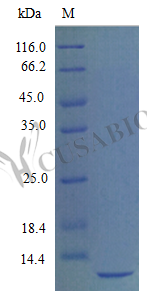Recombinant Mouse Stromal cell-derived factor 1 protein (Cxcl12) is produced in E. coli and spans amino acid region 22-89, creating a partial protein without any tags. The protein achieves high purity, with levels exceeding 97% as determined by SDS-PAGE. Testing confirms it remains fully biologically active and shows chemotactic activity in bioassays with human peripheral blood monocytes at concentrations ranging from 50-100 ng/ml. Endotoxin levels stay below 1.0 EU/µg, ensuring minimal contamination.
Stromal cell-derived factor 1 (Cxcl12) functions as a chemokine central to cellular signaling. It plays a key role in chemotaxis, guiding the migration of various cell types throughout the body. This protein participates in multiple biological processes, including hematopoiesis and immune response regulation. Cxcl12 has become widely studied for its involvement in developmental and physiological pathways, making it an important focus for research into cellular communication and migration.
Potential Applications
Note: The applications listed below are based on what we know about this protein's biological functions, published research, and experience from experts in the field. However, we haven't fully tested all of these applications ourselves yet. We'd recommend running some preliminary tests first to make sure they work for your specific research goals.
1. Chemotaxis Assay Development and Optimization
This recombinant mouse CXCL12 is confirmed to be biologically active in human monocyte chemotaxis (50-100 ng/ml) and suitable as a positive control. However, researchers should validate its activity in mouse-specific cell types and note that the partial sequence may exhibit different potency compared to full-length CXCL12. The high purity supports reliable dose-response studies, but optimal concentrations may need adjustment for different cell types.
2. CXCR4 Receptor Binding Studies
The protein is appropriate for CXCR4 binding studies, but the partial sequence may affect binding kinetics compared to full-length CXCL12. The 22-89aa region contains the core receptor-binding domain, but researchers should validate that binding affinity matches full-length protein characteristics. Competition binding assays should include full-length CXCL12 as a reference standard.
3. Cell Culture Supplementation for Migration Studies
This CXCL12 can be used to create chemokine gradients, but the partial sequence may alter gradient stability and diffusion properties due to differences in heparin-binding capacity. The defined activity range provides a starting point, but researchers should optimize concentrations for their specific assay format and account for potential reduced glycosaminoglycan interactions.
4. Antibody Development and Validation
This protein serves as a good antigen, but the partial sequence will generate antibodies with limited epitope coverage. Antibodies should be validated against full-length CXCL12 to ensure recognition of all relevant domains. The confirmed bioactivity supports the development of function-blocking antibodies targeting the receptor-binding region.
5. Protein-Protein Interaction Studies
The protein is suitable for studying core interactions with CXCR4, but the partial sequence lacks the C-terminal region important for glycosaminoglycan binding and some regulatory interactions. Studies focusing on heparin/glycosaminoglycan binding should use full-length CXCL12, as this truncated form may show reduced affinity.
Final Recommendation & Action Plan
This recombinant partial mouse CXCL12 is a functional reagent suitable for basic chemotaxis and receptor binding studies, but researchers should be aware of limitations due to the truncated sequence. Prioritize validating key findings with full-length CXCL12, particularly for studies involving glycosaminoglycan interactions or requiring full biological activity. For chemotaxis assays, use the 50-100 ng/ml range as a starting point, but perform optimization for specific cell types. When developing antibodies, supplement with the full-length antigen to ensure comprehensive epitope coverage. The high purity and low endotoxin make it valuable for controlled experiments, but always include appropriate controls accounting for the partial nature of this protein. For most applications, this reagent provides a cost-effective alternative to full-length CXCL12 when core receptor-binding function is sufficient.






